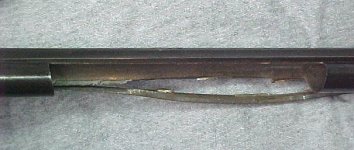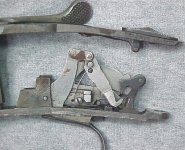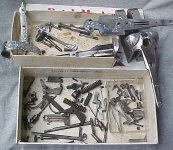A Fox, Ithaca NID, Lefever Nitro Special(Ithaca mfg-especially the A grade guns) are all good sturdy shooters. Some have better stock dimentions than others,,something you'll have to try yourself to see if it fits. I had a nice Fulton also, marked Worthington, and it was an excellent shotgun. A heavy shotgun but a reliable one. I shot it almost weekly for 2 years at skeet and trap before trading it off. Another one to consider as already mentioned.
I'll also add to take a look at bore dimentions if at all possible as alot of the older guns have had their bores honed out. Not all have been done to a dangerous limit but some have. Refinishing/blueing of barrels can thin them from the outside excessively as drawfiling is usually the first step most refinishers go to, necessary or not.
A pic attached is of a Parker 20ga Trojan set of barrels that let go in the left tube. The steel thickness is only approx .012/.015". That's very thin. An obstruction may also have been involved but the bores are oversized when mic'd also.
Also,, detecting a loose rib by ringing the barrels does work. However it may not tell you if there is a loose gap mid way in the rib. It is at it's best detecting a loose rib at the very ends of the rib where it can vibrate freely. But don't bypass using the trick in checking out the barrels, just visually check them very closely as well. Rapping the rib with your knuckle will also detect a loose one as it clicks against the barrel where it's loose.
Ithaca NID (ser#s 400,00's,,,Magnums--500,000's) will have modern chamber dimentions IIRC, the other makes will vary with the older ones having 'short chambers' (2 5/8' in 12 ga). This doesn't worry alot of the modern day shooters who put 'PROPER' loads through these older guns. Modern plastic hulls and wads pose little problems with the shorter chambers in the lower preasure range shells.
Push it, and you may have a problem, though these guns have been around in the modern shell age for a long time and have swallowed more than a few.
If anything I'd advise lengthening the forcing cone only, over lengthening the entire chamber.
The second pic is a 410 LC Smith that a rather well known 'smith worked on to repair the single trigger and safety problem. The trigger didn't work and the safety didn't hold on SAFE.
He 'fixed' it by removing the safety linkage completely! (took care of that problem),,the trigger still doesn't kick over to the second barrel.
The safety detent spring is freshly broken on left side too.
Wish he had kept the linkage......the barrels were hot blued too but I don't know who did that, at least no one will admit to it. A specialty grade 410,,,,,sad,,
I'll have to take the ribs off the barrels clean them up, polish, recut and resolder everything and then reblue.
Last is a look at a disasssembled Parker CHE. Lots of parts in there!
Many more than a Fox or Ithaca.
It's been polished and recut, wood is being refinished, barrels reblued etc. The small tray to the right inside the larger box is just the ejector parts alone. Lots of potential problems but this one is in exc mechanical condition for a 1908 gun.
Just a look at a few potential problems and a few more things to look for.





